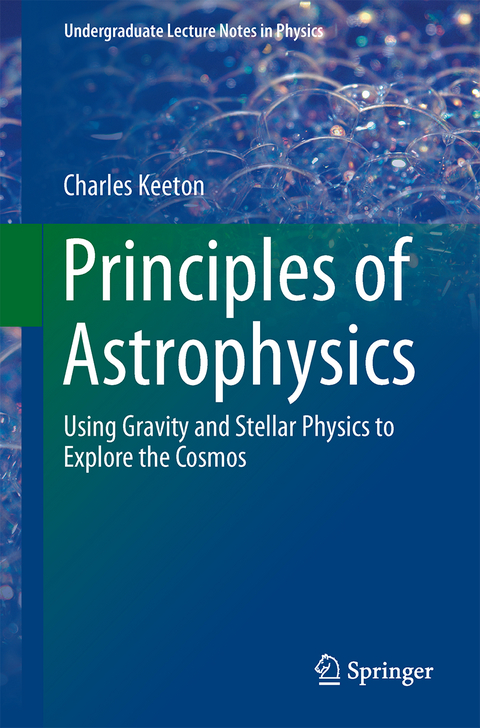
Principles of Astrophysics
Springer-Verlag New York Inc.
978-1-4614-9235-1 (ISBN)
This book gives a survey of astrophysics at the advanced undergraduate level, providing a physics-centred analysis of a broad range of astronomical systems. It originates from a two-semester course sequence at Rutgers University that is meant to appeal not only to astrophysics students but also more broadly to physics and engineering students. The organisation is driven more by physics than by astronomy; in other words, topics are first developed in physics and then applied to astronomical systems that can be investigated, rather than the other way around.
The first half of the book focuses on gravity. The theme in this part of the book, as well as throughout astrophysics, is using motion to investigate mass. The goal of Chapters 2-11 is to develop a progressively richer understanding of gravity as it applies to objects ranging from planets and moons to galaxies and the universe as a whole. The second half uses other aspects of physics to address one of the bigquestions. While “Why are we here?” lies beyond the realm of physics, a closely related question is within our reach: “How did we get here?” The goal of Chapters 12-20 is to understand the physics behind the remarkable story of how the Universe, Earth and life were formed. This book assumes familiarity with vector calculus and introductory physics (mechanics, electromagnetism, gas physics and atomic physics); however, all of the physics topics are reviewed as they come up (and vital aspects of vector calculus are reviewed in the Appendix).
Charles Keeton earned a B.A. in Physics (summa cum laude) from Cornell University in 1994, and a Ph.D. in Physics from Harvard University in 1998. He held the Bart J. Bok Fellowship at the University of Arizona and a NASA Hubble Fellowship at the University of Chicago before joining the faculty of Rutgers University in 2004. Keeton has published 89 refereed journal articles in major international astronomy journals. He has received the following awards: •2007: Rutgers Society of Physics Students, Outstanding Teacher Award •2010: White House, Presidential Early Career Award for Scientists and Engineers •2010: Rutgers University, Presidential Fellowship for Teaching Excellence •2010: Rutgers University, Board of Trustees Fellowship for Scholarly Excellence In 2011, Keeton was named Faculty Director of the Aresty Research Center for Undergraduates at Rutgers University.
Introduction: Tools of the Trade.- Part I: Using Gravity and Motion to Measure Mass.- Celestial Mechanics.- Gravitational One-Body Problem.- Gravitational Two-Body Problem.- Tidal Forces.- Gravitational Three-Body Problem.- Extended Mass Distributions: Spiral Galaxies.- N-Body Problem: Elliptical Galaxies.- Bending of Light by Gravity.- Relativity.- Cosmology: Expanding Universe.- Part II: Using Stellar Physics to Explore the Cosmos.- Planetary Atmospheres.- Planetary Temperatures.- Stellar Atmospheres.- Nuclear Fusion.- Stellar Structure and Evolution.- Stellar Remnants.- Charting the Universe with Stars.- Star and Planet Formation.- Cosmology: Early Universe.- Part III: Appendices.- Appendix A: Technical Background.- Appendix B: Solutions.
| Reihe/Serie | Undergraduate Lecture Notes in Physics |
|---|---|
| Zusatzinfo | 37 Illustrations, color; 82 Illustrations, black and white; XXI, 434 p. 119 illus., 37 illus. in color. |
| Verlagsort | New York, NY |
| Sprache | englisch |
| Maße | 155 x 235 mm |
| Themenwelt | Naturwissenschaften ► Physik / Astronomie ► Astronomie / Astrophysik |
| Naturwissenschaften ► Physik / Astronomie ► Mechanik | |
| Technik ► Maschinenbau | |
| Schlagworte | Astrophysical Estimation Techniques • Celestial mechanics • cosmological expansion • general relativity theory • Gravitational Problems • Special Relativity Theory • Stellar Properties • Tidal Forces Explained |
| ISBN-10 | 1-4614-9235-1 / 1461492351 |
| ISBN-13 | 978-1-4614-9235-1 / 9781461492351 |
| Zustand | Neuware |
| Haben Sie eine Frage zum Produkt? |
aus dem Bereich


